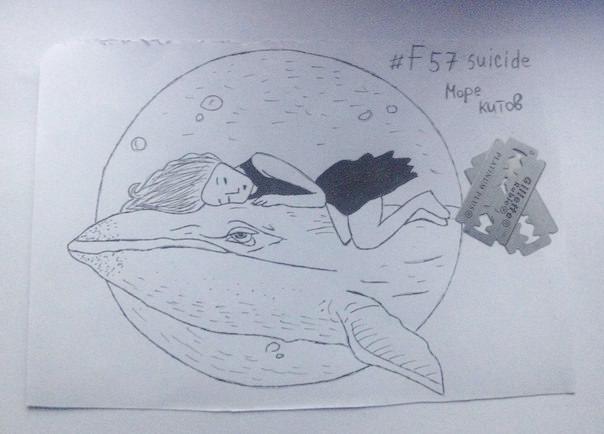One hundred and thirty suicides of children had occurred in Russia from November 2015 through April 2016. Almost all of these children lived in safe and loving homes. But they were members of the same social groups on the Internet and the news about their deaths had been announced in these same Internet groups.
Russian newspaper Novaia Gazeta (New Gazette) made an investigation of these events and published the results in an article written by Galina Mursalieva. The article unexpectedly made a sensation of the proportions unprecedented in contemporary Russia. It was read by almost two million readers and triggered a passionate discussion on Russian media.
According to the investigation more then 1500 groups, developing suicide sentiments and Death cults among teenagers, operate now in Russian social networks. The sites praise butterflies, which live only one day and whales that commit suicides by throwing themselves to shores. The contents of such sites usually start with innocent pictures of pets and animals, leading to message of this kind: “Are you a girl? Have your friends betrayed you? Have your boyfriend deserted you? Are you often listening to sad music? Subscribe to the “Whales swimming up!”
There are dozens of groups which titles contain the word “whale” just in the network “V kontakte”, the Russian analog of Facebook.
Here is a message left by a girl several days prior to her suicide at one of these web pages:
“You will never understand how it is to live being so huge as a whale. Whales are wiser then people. They are gorgeous. I’ve seen how they are flying. You know why they throwing themselves on the shore? They are desperate.”
The 16 years old Siberian girl Rena Pavlenkova became a real heroine to Russian teenagers after throwing herself under a train. The photographs of her mutilated body and her cut off head literary filled the Internet. It looks like she committed her suicide surrounded by photographers.
The Internet web page devoted to Rena has thousands of subscribers. Rena’s photographs became icons. One can find in the Internet thousands of drawings devoted to Rena and the other suicide girls.
 The investigation of Novaia Gazeta was met with hundreds of very diverse comments. Some commentators demanded immediate actions against creators of the websites popularizing suicides. Others blamed publishers of the investigation for creating a false panic. They claim that statistics of teenage suicides stays unchanged during many years and death cult Internet sites represent innocent children games and their effect is similar to the effect of scary fairy tales, traditionally loved by children, and also of horror movies and they don’t influence suicide statistics at all.
The investigation of Novaia Gazeta was met with hundreds of very diverse comments. Some commentators demanded immediate actions against creators of the websites popularizing suicides. Others blamed publishers of the investigation for creating a false panic. They claim that statistics of teenage suicides stays unchanged during many years and death cult Internet sites represent innocent children games and their effect is similar to the effect of scary fairy tales, traditionally loved by children, and also of horror movies and they don’t influence suicide statistics at all.
There is no way to check which sources of information were used by the different Russian writers. Those who think that worries about teenage suicides are a “false panic” may either believe that Russian figures of teenage suicides were always as high, or don’t believe modern Russian statistics at all. They may be wrong.
One thing is clear: Almost none of psychologists agree with the theory that suicides are caused by the influence of the Internet. They think that the problem is caused by the general condition of the Russian society. They believe a teenagers’ mood would be the same even if there were no Internet.
Here is a comment of one of Russian Internet readers:
“Russia ranked first in the world:
in the number of suicides among the elderly, children and adolescents;
in the number of divorces and children born out of wedlock;
in the number of abortions and the number of children abandoned by their parents;
in the consumption of alcohol and in the tobacco sales;
in the number of deaths from alcohol and tobacco.
It ranks 2nd in the world in the heroin consumption (21% of world consumption).
It seems that all of those indicators are interrelated and clearly not accidental.”
The interviewer of TVRain.ru asked Dmitri Muratov, Chief Editor of Novaia Gazeta, why does he think his paper’s publication became so big event in Russia. Dmitri Muratov answered:
“I think there is a certain alienation between the generation of parents and the “digital” generation.
The parents suddenly realized how much they do not know, how much they do not notice that there is something deep, serious, sometimes tragic in lives of their children. It made the parents turn to face the children. A wonderful schoolgirl, I think her name was Skulskaya, wrote a letter criticizing us. She said: ‘You have turned away from our affection, and turned to us with control’. And suddenly, after Galina Murzalieva’s article was published, and followed by fantastic debate, which started after this publication, it became clear that the children have to turn, at least a little bit, half-turned, to parents, and parents – to children. This was a major purpose for publication of this article, this material, and of course, this aim is reached.”


